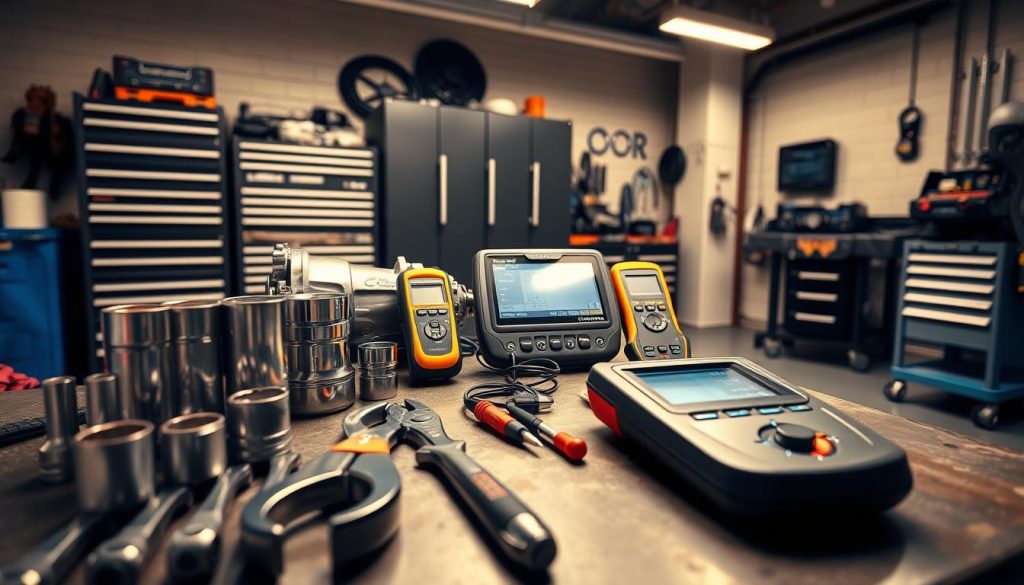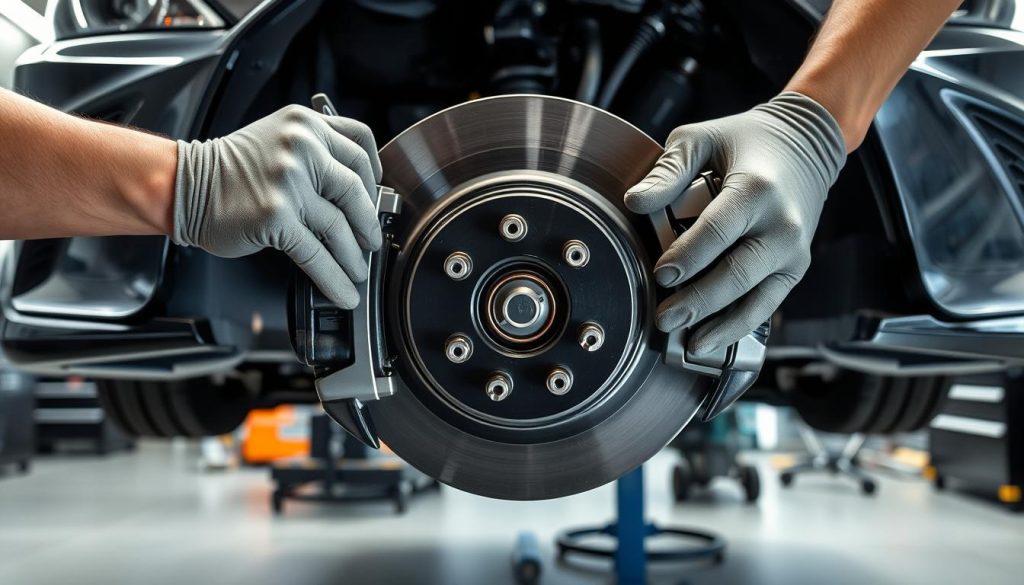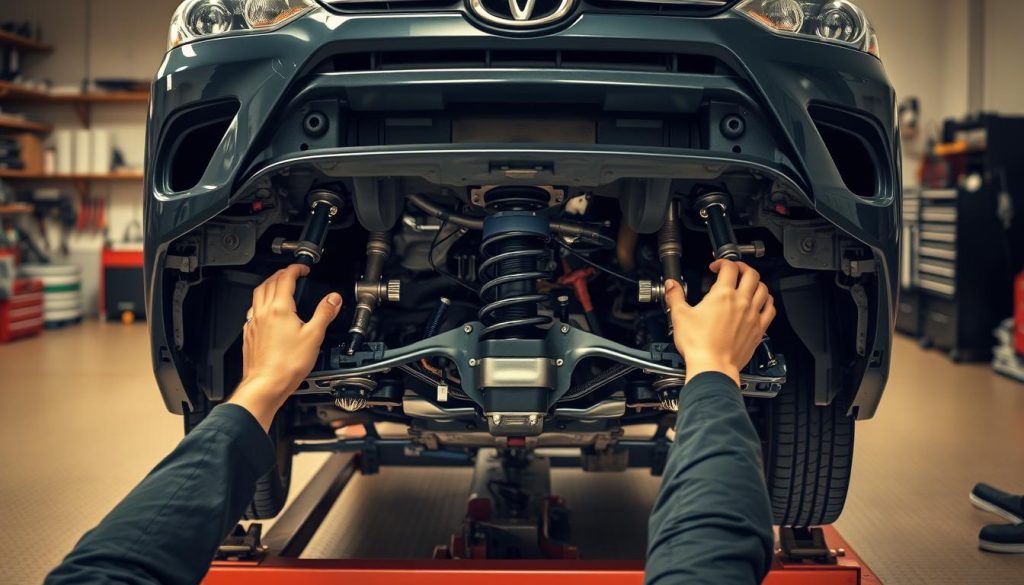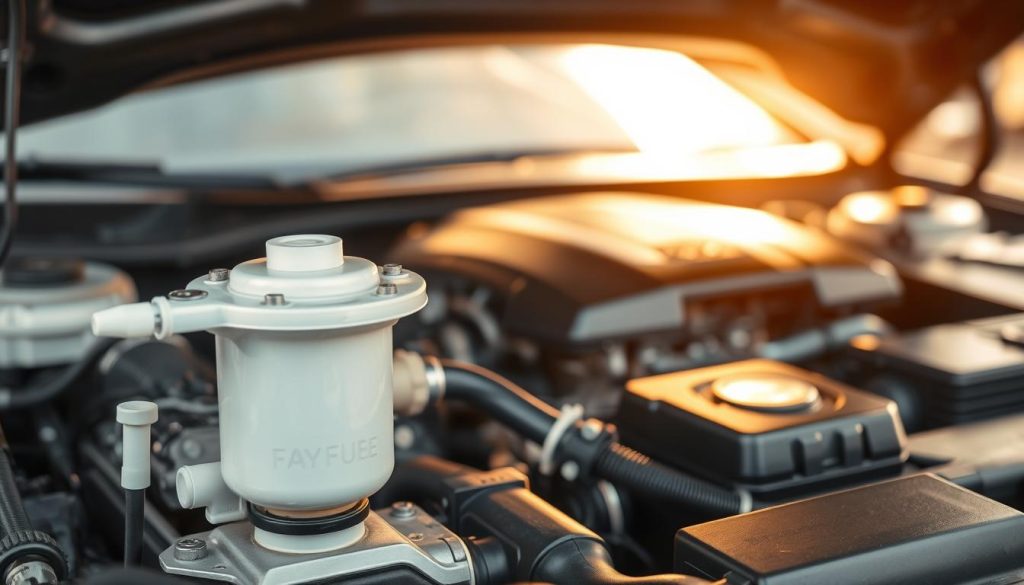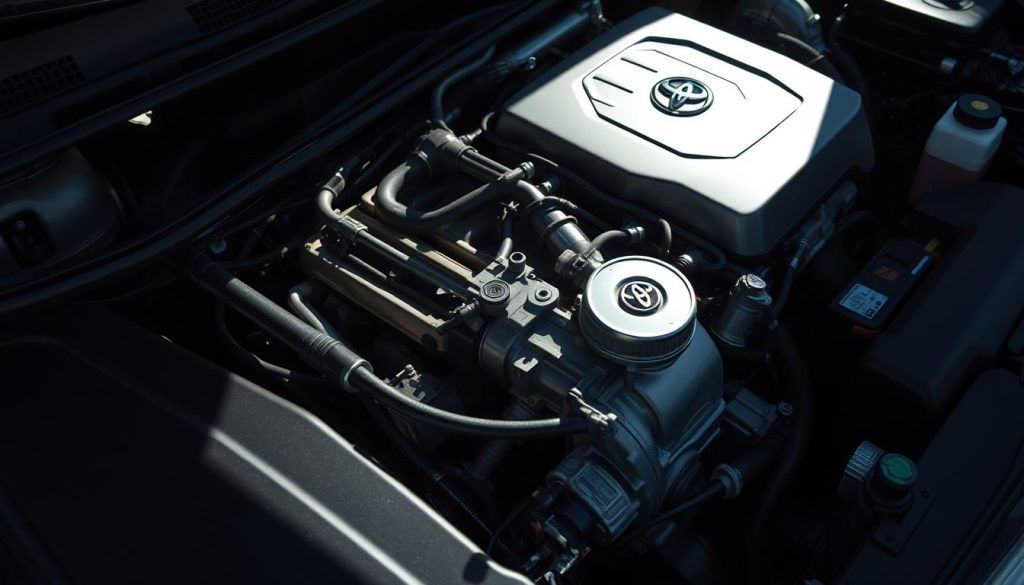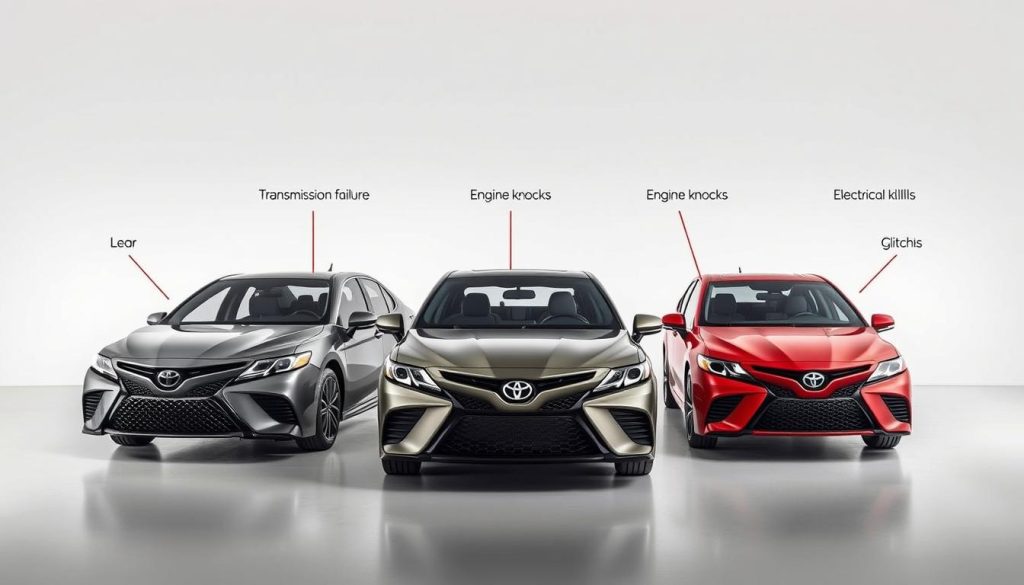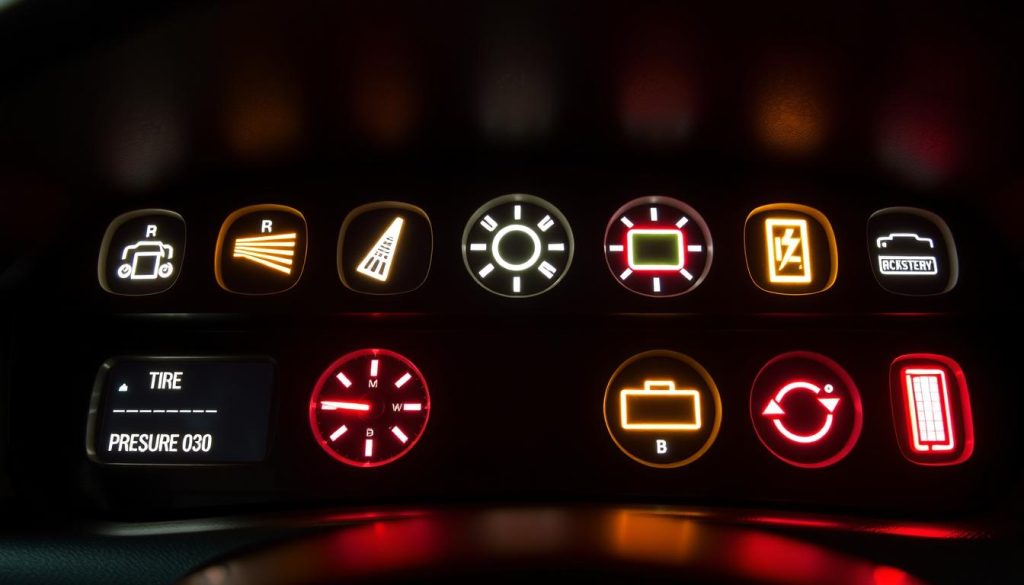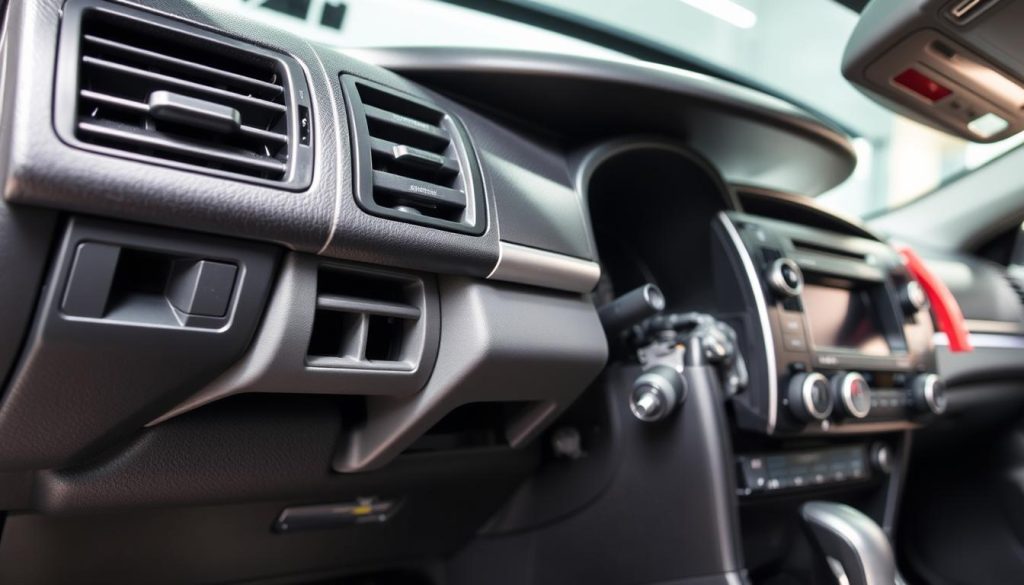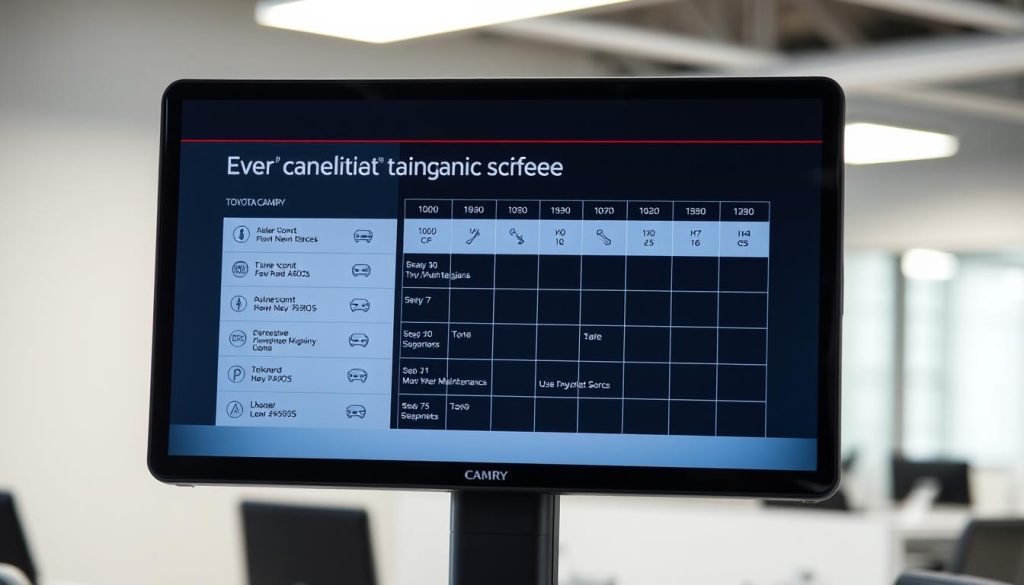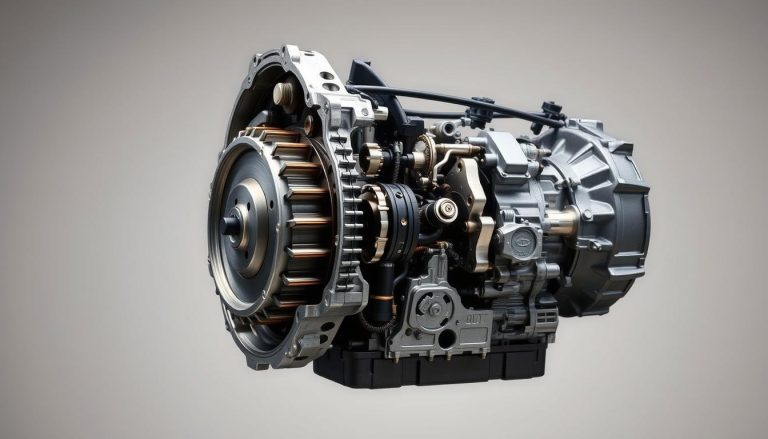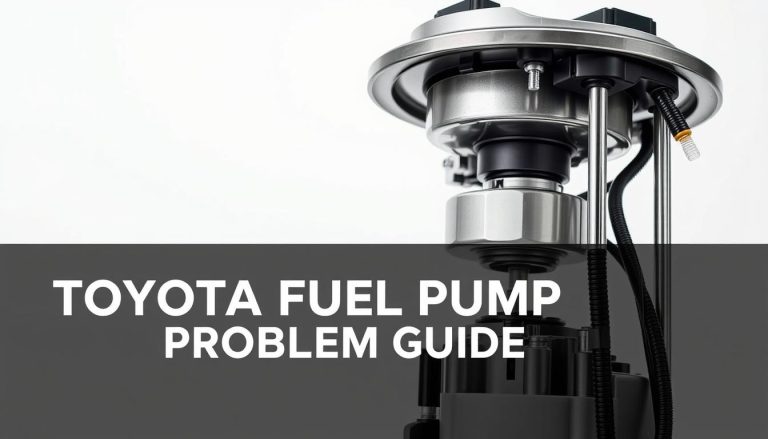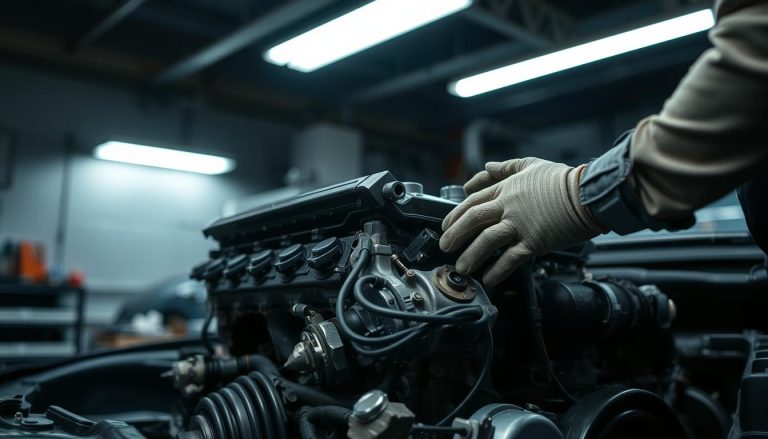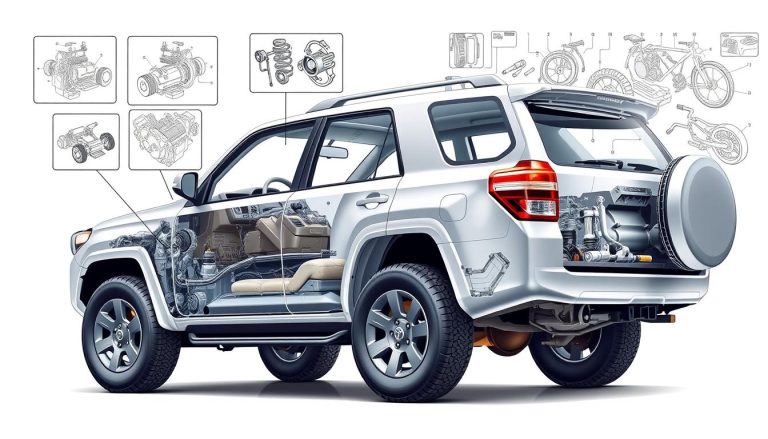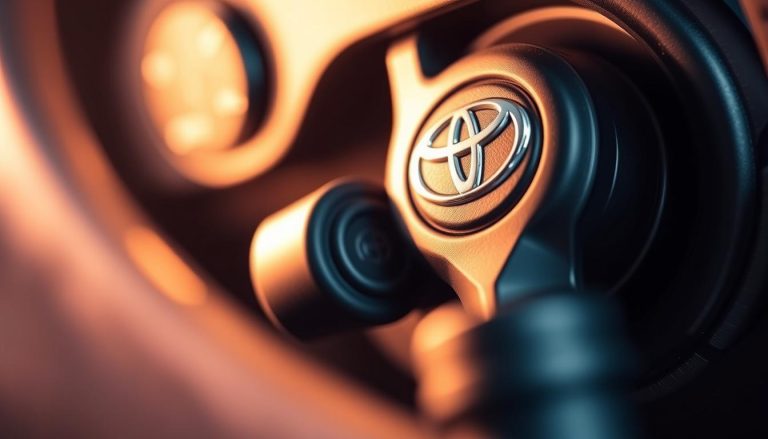Most Common Toyota Camry Problems and Fixes
The Toyota Camry is a top choice for many, known for its reliability and performance. Yet, even the best cars can face Toyota Camry issues as they age.
This detailed car maintenance guide will help you spot and fix common problems. We’ll cover everything from check engine lights to power steering leaks. You’ll learn how to keep your car running well.
Issues like engine warning lights, worn motor mounts, oil leaks, and transmission problems are common. These problems might seem daunting, but most have simple fixes once you know what to look for.
Our guide makes vehicle troubleshooting easy, giving you the confidence to fix things yourself or know when to call a pro. Whether it’s strange noises or performance issues, we offer clear steps to keep your Camry running smoothly.
Key Takeaways
- Even reliable vehicles like the Camry can develop common issues over time
- Check engine lights, power steering leaks, and oil leaks are frequent concerns
- Motor mount wear and transmission issues require prompt attention
- Many problems have straightforward DIY solutions with proper guidance
- Knowing when to seek professional help can prevent costly repairs
- Regular maintenance prevents most common issues from developing
Understanding Your Toyota Camry’s Warning Signs
Your Toyota Camry has warning signs that can save you money. Learning to spot these signs early can prevent costly repairs. It’s important to know what these lights mean to stay in control.
The check engine light is a common issue for Camry owners. It often means the oxygen sensors are faulty. These sensors can cost over $300 to replace.
How to Identify Early Problem Indicators
Your Camry talks to you in many ways, not just through lights. Unusual sounds like grinding or squealing can mean something’s wrong. Vibrations in the steering wheel or seat might point to alignment or suspension issues.
Be aware of strange smells inside or around your car. Burning oil or sweet coolant odors can signal problems. Also, watch for changes in how your car performs, like rough idling or poor acceleration.
Essential Tools for DIY Diagnostics
Every Camry owner should have basic diagnostic tools. An OBD-II scanner helps find specific problems quickly. A digital multimeter tests electrical parts like batteries and sensors.
Other useful tools include a tire pressure gauge, flashlight, and basic hand tools. These help with inspections and diagnostics at home.
Safety Precautions Before Starting Repairs
Always be safe when doing diagnostic work. Park on level ground and use the parking brake. Let the engine cool before checking fluids or touching engine parts.
Wear safety glasses and gloves when working on your car. Keep a fire extinguisher nearby when dealing with electrical or fuel systems. Never work under a car that’s only supported by a jack.
| Warning Sign Type | Common Indicators | Urgency Level | Typical Cost Range |
|---|---|---|---|
| Dashboard Lights | Check engine, oil pressure, battery | Medium to High | $100-$800 |
| Unusual Sounds | Grinding, squealing, knocking | High | $200-$1,500 |
| Performance Changes | Poor acceleration, rough idle | Medium | $150-$600 |
| Fluid Leaks | Oil, coolant, brake fluid spots | Medium to High | $75-$400 |
Transmission Slipping and Shifting Issues
Many Camry owners face automatic transmission problems. Yet, most issues start with simple signs you can catch early. Transmission hesitation during acceleration is a common complaint. It feels like your vehicle is struggling to engage properly.
This delay can come from computer glitches or worn parts in older vehicles. Knowing these signs early can save you from expensive repairs. These repairs can cost over $1,000.
Identifying Transmission Problems
Look out for these signs of Camry shifting problems:
- Delayed engagement when shifting from park to drive
- Rough or jerky gear changes during acceleration
- Slipping gears that cause engine revving without speed increase
- Unusual whining or grinding noises during shifts
- Burning smell from under the hood
These symptoms start mild but get worse over time. Don’t ignore early warning signs – they’re your transmission’s cry for help.
Checking Transmission Fluid Level and Condition
Your transmission fluid is both lubricant and hydraulic fluid. Check it monthly with these steps:
- Warm up your engine for five minutes
- Park on level ground with engine running
- Pull the transmission dipstick and wipe it clean
- Reinsert fully, then pull out to check level
Healthy fluid is bright red and smells sweet. Dark brown or black fluid with a burnt odor means serious problems.
Performing Basic Transmission Maintenance
Regular maintenance extends your transmission’s life. Change transmission fluid every 30,000 to 60,000 miles. Stop-and-go traffic and towing need more frequent changes.
Use only Toyota-approved transmission fluid. Generic fluids can damage your transmission and void your warranty.
When to Contact a Professional Mechanic
Some transmission problems need a pro. Call a qualified mechanic if you see:
- Complete loss of gear engagement
- Transmission overheating warnings
- Metal particles in transmission fluid
- Computer error codes related to transmission control
Trying complex transmission repair without the right tools and knowledge can cause more damage. Professional diagnosis is cheaper than replacing a damaged transmission.
Excessive Engine Oil Consumption
Many Toyota Camry models, with the 2.5-liter engine, face oil consumption problems. This issue gets worse as the car gets older. Ignoring this can cause serious engine damage and high repair costs.
It’s important to know when oil use is normal and when it’s not. Most engines use a bit of oil when running. But, if you use more than a quart between oil changes, you should act fast.
Monitoring Oil Levels and Usage
Checking oil levels regularly is key to Toyota maintenance. Use the dipstick when the engine is cool. Write down the date and mileage each time you add oil.
Keep a log to track oil use. Note how many quarts you add between oil changes. Normal use should not be more than one quart per 1,000 miles for most Toyota engines.
| Mileage | Date | Oil Added (Quarts) | Notes |
|---|---|---|---|
| 45,230 | Jan 15 | 0.5 | Slight low reading |
| 45,890 | Feb 2 | 1.0 | Below minimum mark |
| 46,400 | Feb 20 | 0.75 | Consumption increasing |
Inspecting for Oil Leaks
Leaks outside the engine are different from oil use inside. Look for dark spots or puddles under your car. Check the valve cover gasket, oil pan, and drain plug for leaks.
Fixing leaks might need professional help. But, you can find where leaks are. Clean the engine area and watch for fresh oil spots after driving.
Changing Oil and Filter Properly
Use the right oil viscosity for your model year. Change the oil filter with each oil change. Good oil and filters help your engine last longer and might lower oil use.
Dispose of used oil safely. Most auto parts stores recycle used oil and filters. Never throw oil down drains or on the ground.
Addressing Severe Oil Consumption Issues
When oil use is way too high, you need a mechanic’s help. Problems like worn piston rings or valve seals need big repairs. These issues often hit cars with lots of miles.
Think about your car’s value before big repairs. Sometimes, adding oil often is cheaper than fixing the engine. Talk to trusted mechanics to find the best solution.
Brake System Warning Signs and Fixes
Knowing brake system warning signs in your Toyota Camry can save lives. Your brakes are the hardest working part of your car. Spotting problems early saves money and keeps you safe.
Look out for squeaking, grinding, or scraping sounds when you brake. You might also feel vibrations in the brake pedal or steering wheel. If your brakes feel different or take longer to stop, it’s a sign of trouble.
Recognizing Brake Problems
Listen for unusual sounds when you brake. Squealing or squeaking means your brake pads need to be replaced. Grinding sounds mean metal is rubbing against metal, damaging your rotors.
Check how your brake pedal feels. A soft or spongy pedal can mean air in the lines or low brake fluid. Proper Camry brake maintenance helps avoid these issues.
Inspecting Brake Pads and Rotors
Look at your brake pads through the wheel spokes. They should be at least 1/4 inch thick. If they’re thinner, you need to replace them right away.
Check your rotors for damage like deep grooves or rust. If they’re smooth and even, they’re good. Professional brake system repair is needed if your rotors are worn or warped.
Checking and Replacing Brake Fluid
Brake fluid should be clear or light amber. Dark fluid means it’s contaminated and your brakes won’t work well. Change your brake fluid every two years or as your owner’s manual says.
Check your brake fluid levels every month. Low fluid can mean worn brake pads or leaks. You’ll need to get your brakes fixed right away.
| Warning Sign | Possible Cause | Action Required | Urgency Level |
|---|---|---|---|
| Squealing noise | Worn brake pads | Replace pads | Medium |
| Grinding sound | Metal-on-metal contact | Immediate repair | High |
| Spongy pedal | Air in brake lines | Bleed brake system | High |
| Longer stopping distance | Multiple brake issues | Professional inspection | Critical |
Safety Warnings for Brake Repairs
Never compromise on brake safety. If you’re not sure about brake repairs, get a professional mechanic. Wrong brake work can lead to brake failure.
Always use proper jack stands when working under your car. Regular brake maintenance keeps your family safe and avoids costly repairs.
Air Conditioning System Failures
A broken AC system can make your Camry unbearable in summer. Many Camry owners face issues like weak airflow or system failure. Knowing these problems helps keep you comfortable and saves money on repairs.
The 2012-2014 Camry models had big air conditioning maintenance problems. A lawsuit showed these cars could grow mold in the AC, causing bad smells and health issues.
“Regular AC system maintenance prevents 80% of common cooling problems and extends system life by several years.”
Diagnosing AC Performance Issues
First, check if air flows well from all vents. Weak airflow means clogged filters or blocked ducts. Also, listen for odd noises when the AC turns on.
Make sure the temperature is even across vents. Uneven cooling means refrigerant problems or a failing blend door. Watch out for musty smells, which could be mold.
Checking Refrigerant and Compressor
Look for oily spots on AC parts to find leaks. The compressor clutch should move when you turn on the AC.
Use manifold gauges to check refrigerant pressure. Low pressure means leaks, while high pressure points to blockages or overcharging.
Cleaning and Replacing AC Filters
Change cabin air filters every 12,000-15,000 miles for best Camry climate control performance. These filters keep dust, pollen, and debris out.
Keep evaporator drains clean to avoid water buildup and mold. Clogged drains cause bad smells and can damage interior parts.
Professional AC Repair Recommendations
Handling refrigerant needs EPA certification and special tools. Pros can safely fix your AC while following environmental rules.
Replacing compressors and finding leaks require expert skills. These jobs need special tools and knowledge to ensure your AC works right and lasts long.
Electrical System Malfunctions
Modern Toyota Camrys have complex electrical systems. These systems power everything from the engine to comfort features. If they fail, you might see flickering lights or dead power windows.
Understanding your car’s electrical components is key to fixing issues. Your Camry’s system includes the battery, alternator, starter, and lots of wiring. This wiring connects sensors, computers, and accessories all over the car.
Testing Battery Performance
Battery testing uses a digital multimeter. First, measure voltage at the battery terminals with the engine off. A good battery should have 12.6 volts or more.
Turn on your headlights and check the voltage again. If it’s below 12.4 volts, your battery might be weak. For load testing, start the engine and rev it to 2000 RPM. The voltage should stay above 13.5 volts, showing the charging system works right.
Checking Alternator Function
Your alternator keeps the battery charged and powers systems while driving. Signs of problems include dim headlights or slow power windows.
With the engine running, measure voltage at the battery terminals. Readings between 13.8 and 14.4 volts mean the alternator is working. Lower readings could mean the alternator or belt is failing.
Inspecting Fuses and Wiring
Blown fuses can cause electrical issues in Toyota Camrys. Check your owner’s manual for fuse boxes under the hood and inside. Look for broken metal strips or dark spots to find blown fuses.
Automotive wiring inspection looks for corrosion, loose connections, and damaged insulation. Check for green or white corrosion on battery terminals. Clean with baking soda and water if you find it.
| Component | Normal Reading | Problem Indicator | Action Required |
|---|---|---|---|
| Battery Voltage | 12.6V (engine off) | Below 12.4V | Replace battery |
| Alternator Output | 13.8-14.4V (running) | Below 13.5V | Test alternator/belt |
| Fuse Condition | Metal strip intact | Broken or dark | Replace fuse |
| Wire Connections | Clean and tight | Corrosion present | Clean terminals |
Electrical Safety Precautions
Always disconnect the negative battery terminal before working on electrical parts. This prevents short circuits that could damage expensive computer modules or cause fires.
Never work on electrical systems with wet hands or in damp conditions, as water and electricity create dangerous situations that can result in serious injury.
Use insulated tools when possible and avoid touching multiple electrical connections at once. If you face complex wiring problems or computer issues, professional diagnosis with specialized equipment is needed for safe and effective repairs.
Suspension and Steering Problems
Suspension and steering issues can make your Toyota Camry uncomfortable and unsafe. These systems keep your car stable and responsive. When they fail, your car’s handling changes.
Early detection of suspension problems can prevent costly repairs and dangerous driving situations. Your Camry needs these systems for good tire contact. Ignoring signs can lead to more damage and higher costs.
Identifying Suspension Issues
Look out for signs of steering or suspension trouble. Excessive bouncing after hitting bumps means worn shock absorbers. Your car should settle quickly after bumps.
Uneven tire wear shows alignment or suspension failure. Check your tires for unusual wear. Nose diving during braking or excessive body roll in corners also signals suspension wear.
Inspecting Struts and Shock Absorbers
Do the bounce test by pushing down on each corner of your Camry. It should bounce once and settle. Multiple bounces mean worn parts need replacement.
Fluid leaks around struts and shocks indicate seal failure. Check for rust, damage, or play in mounting hardware.
Checking Wheel Alignment
Proper wheel alignment prevents tire wear and ensures straight tracking. If your Camry pulls to one side, alignment may need adjustment. Steering wheel vibration or off-center positioning also indicates wheel alignment problems.
Regularly check tire pressure, as incorrect pressure can mimic alignment issues. Keep tires at the manufacturer’s recommended pressure for accurate diagnosis.
When Suspension Repairs Require Professional Help
While basic inspections are doable, most suspension repairs need special tools and knowledge. Safety-critical components like struts, control arms, and steering linkages need professional installation.
“Suspension work involves your vehicle’s ability to stop and steer safely – never compromise on quality when these systems need repair.”
Professional mechanics have the right tools and knowledge for repairs. Trying complex suspension work without proper tools can be dangerous.
Fuel System and Engine Performance Issues
Your Toyota Camry’s fuel system is like its engine’s blood, delivering the right mix for top performance. If it fails, you might see signs like rough idling, slow acceleration, or lower fuel efficiency. Proper fuel system maintenance helps avoid expensive fixes and keeps your Camry running well.
Diagnosing Fuel System Problems
Look for common signs of fuel delivery issues. Listen for engine hesitation or odd idling sounds.
Check your fuel economy records for sudden drops. Also, notice if your Camry is hard to start, even when cold. These signs often mean fuel pump or clogged parts problems.
Cleaning Fuel Injectors
Start fuel injector cleaning with quality additives every 3,000 miles. Add the cleaner to your fuel tank before filling up for best mixing.
For tough buildup, try ultrasonic cleaning services. This method gets rid of hard-to-remove deposits. Do this every 30,000 miles for the best results.
Replacing Fuel Filter
Find your fuel filter, usually along the fuel line or inside the tank. Replace inline filters every 15,000 miles to stop contamination.
Always release fuel pressure before starting this job. Use the right tools and work in a well-ventilated area, away from heat.
Engine Performance Optimization Tips
Use top-tier gasoline with additives to keep injectors clean. Don’t let your fuel level get too low, always keep it above one-quarter tank.
Change your air filter every 12,000 miles for the right air-fuel mix. Stick to regular fuel system maintenance to keep your Camry reliable and efficient.
Cooling System Overheating Problems
Cooling system failures can turn a reliable Toyota Camry into a costly repair quickly. Engine overheating is one of the most dangerous issues your car can face. When the cooling system fails, engine temperatures can rise too high.
Regular coolant maintenance and catching problems early can prevent expensive engine damage. Knowing the warning signs and how to fix them keeps your Camry running well for years.
Identifying Overheating Symptoms
Keep an eye on your temperature gauge while driving. The needle should stay between the cold and hot marks. If it goes up, it might mean cooling system trouble.
Steam coming from under the hood is a big warning sign. Pull over safely if you see white vapor or unusual smells. Sweet coolant smells often mean your engine is overheating.
How well your heater works can also show cooling issues. If it’s not warming up your car in winter, it might be a sign of low coolant or circulation problems.
Checking Coolant System Components
Start by checking the radiator for leaks, bent fins, or blockages. Clean off dirt and insects from the radiator regularly.
Look at all coolant hoses for cracks, bulges, or soft spots. Squeeze them gently when the engine is cool. Replace any hoses that feel soft or show damage.
Test your cooling fans by running the air conditioning. Both fans should turn on when the AC is on at idle. Listen for strange noises from the water pump area.
Flushing and Refilling Coolant
Do a full coolant maintenance every 30,000 miles or as the manual suggests. Drain the old coolant before adding new. Use only Toyota-approved coolant for the best protection.
Mix the coolant with distilled water in the right ratio. Most cars need a 50/50 mix for all-year protection. After refilling, bleed air bubbles from the system.
Emergency Overheating Procedures
Turn off the air conditioning right away if overheating starts. Turn on the heater full blast to cool the engine. Pull over to a safe spot quickly.
Never open the radiator cap while the engine is hot. Wait at least 30 minutes for it to cool down before checking fluids. It’s best to call a professional to avoid more damage.
Most Common Toyota Camry Problems by Generation
Toyota reliability changes a lot across different Camry model years and generations. Each era has its own set of challenges. Knowing your Camry’s generation helps you plan for repairs and keep up with maintenance.
Different generations have their own common issues. Some years were perfect, while others had costly recalls and widespread problems.
2007-2011 Camry Known Issues and Solutions
The 2007-2009 Camrys faced the most problems in history. Transmission issues were a big problem, with delayed engagement and rough shifting.
These Camry model years also had faulty oxygen sensors that caused check engine lights. Power steering leaks were another expensive issue, costing thousands of dollars.
- Change transmission fluid every 30,000 miles to avoid major failures
- Replace oxygen sensors when check engine lights come on
- Check power steering fluid monthly
- Plan to spend $2,000-4,000 on transmission repairs if needed
2012-2017 Camry Problem Areas and Fixes
This generation saw a big leap in Toyota reliability. The 2013-2015 models got perfect reliability ratings from consumer reports.
After 100,000 miles, air conditioning problems became a big issue. Musty odors and compressor failures led to lawsuits about mold in AC systems.
- Replace cabin air filters every 15,000 miles
- Clean AC evaporator annually to stop mold
- Look for recalls on AC system parts
2018-Present Camry Common Concerns
Today’s Camrys have excellent Toyota reliability and better build quality. They also have more safety features and improved manufacturing.
Even with these improvements, some minor issues might arise. Most problems are related to software updates, not mechanical failures.
Generation-Specific Maintenance Tips
Older Camrys need more frequent transmission service and electrical system checks. Newer models should follow Toyota’s updated maintenance schedules.
Knowing the generation-specific problems helps you keep your Camry in top shape. This way, you can avoid expensive surprises later.
Dashboard Warning Light Troubleshooting
Your Toyota Camry’s dashboard warning lights are important. They tell you about problems before they cost a lot. These lights give feedback on your car’s systems. Knowing what they mean helps you act fast.
Understanding Warning Light Meanings
Each light on your dashboard means something specific. The check engine light often means a problem with oxygen sensors. Lights for oil pressure and temperature warn of issues.
Battery lights tell you if your car’s charging system is failing. Brake lights warn of problems with your brakes. Color coding shows how urgent the problem is. Red means stop right away, yellow is caution, and green is all good.
Using OBD-II Scanner for Diagnostics
An OBD-II scanner reads codes from your Camry’s computer. Plug it into the port under your dashboard. It shows you what’s wrong.
Scanners today give you what the codes mean and how to fix them. Pending codes mean a problem is coming, while active codes mean it’s here now.
Clearing Codes After Repairs
After fixing a problem, use your scanner to clear codes. This resets your car’s computer and turns off the lights. Don’t just pull the battery to avoid other issues.
Let your car run a few cycles to make sure the fix worked. This means driving it a bit to check if the codes come back.
Critical Warning Lights Requiring Immediate Action
Some lights mean you need to stop right away. If you see lights for oil pressure, temperature, or brakes, pull over. It’s for your safety and your car’s.
| Warning Light | Severity Level | Action Required | Driving Safety |
|---|---|---|---|
| Oil Pressure | Critical | Stop immediately | Engine damage risk |
| Temperature | Critical | Stop and cool down | Overheating danger |
| Brake System | Critical | Stop safely | Safety hazard |
| Check Engine | Moderate | Schedule service | Usually safe to drive |
Interior and Exterior Component Repairs
Your Toyota Camry’s interior and exterior parts work hard every time you drive. When they fail, simple tasks become frustrating challenges. These interior repairs might seem less critical than engine problems. But they directly affect your daily comfort and your vehicle’s resale value.
Many Camry owners experience component failures around 85,000 miles. Door lock problems become common at this mileage. Window mechanisms start acting up, and interior trim pieces begin showing their age.
Fixing Door Handle and Lock Issues
Door lock actuators typically fail first in high-mileage Camrys. You’ll notice doors that won’t lock or unlock with the key fob or interior switches.
Start by testing each door individually. If only one door malfunctions, the actuator in that specific door needs replacement. Remove the door panel carefully to access the actuator mechanism.
Replace faulty actuators with OEM or quality aftermarket parts. This repair usually costs $50-150 per door when done yourself, compared to $200-400 at a shop.
Repairing Window and Mirror Problems
Power window regulators wear out over time. You’ll hear grinding noises or notice windows moving slowly or getting stuck halfway.
Test the window switch first – sometimes the problem is electrical. If the motor runs but the window doesn’t move, the regulator assembly needs replacement.
Side mirror adjustments often fail due to worn motor gears. Replace the entire mirror assembly if the adjustment mechanism stops working completely.
Addressing Seat and Trim Damage
Certain Camry model years suffer from melting dashboard problems. This occurs when dashboard materials break down from heat and UV exposure.
Automotive trim repair can restore your interior’s appearance cost-effectively. Use dashboard covers for severely damaged dashboards, or replace trim pieces that have cracked or faded.
| Component | Common Failure Mileage | DIY Cost | Shop Cost |
|---|---|---|---|
| Door Lock Actuator | 80,000-90,000 | $50-150 | $200-400 |
| Window Regulator | 70,000-100,000 | $75-200 | $250-500 |
| Dashboard Trim | 60,000-80,000 | $25-100 | $150-300 |
| Side Mirror Motor | 90,000-120,000 | $40-120 | $180-350 |
Preventive Maintenance Schedule and Tips
Creating a maintenance schedule for your Toyota Camry is like insuring against unexpected breakdowns. Regular checks turn big problems into small tasks. This saves money and makes your car last longer.
Your Camry needs regular care to stay reliable. Smart maintenance planning avoids expensive repairs. A well-planned schedule keeps your car running well for years.
Creating Your Personal Maintenance Calendar
Start by adjusting Toyota’s service schedule to fit your driving. Highway drivers might go longer between services. City drivers need more frequent checks.
Think about your climate and driving style when planning. Extreme temperatures and city driving wear out your car faster. Keep track of your driving to tailor your maintenance.
Monthly Inspection Checklist
Do these checks every month to catch issues early. A detailed vehicle inspection takes just 30 minutes. It prevents big problems later.
- Check all fluid levels including oil, coolant, and brake fluid
- Inspect tire pressure and tread depth
- Test all lights and electrical components
- Examine belts and hoses for cracks or wear
- Listen for unusual noises during operation
Seasonal Maintenance Requirements
Each season has its own needs. Winter needs battery checks and coolant protection. Summer is about air conditioning and cooling system checks.
Spring is for cleaning off winter salt. Fall is for getting ready for cold weather.
Record Keeping for Warranty Protection
Keep detailed records of all preventive maintenance. Good records protect your warranty and increase your car’s value.
| Record Type | Storage Method | Retention Period | Benefits |
|---|---|---|---|
| Service Receipts | Digital and Physical | Vehicle Lifetime | Warranty Protection |
| Maintenance Logs | Smartphone App | 5+ Years | Resale Value |
| Repair Records | Cloud Storage | Vehicle Lifetime | Problem Tracking |
| Parts Warranties | Physical File | Warranty Period | Claim Processing |
Keeping records shows you care for your car. This is key for warranty claims and selling your car.
Cost-Effective Repair and Maintenance Strategies
Smart car owners manage their maintenance costs well. This helps avoid financial stress. For example, fixing a power steering leak can cost thousands. Transmission work starts at around $1,000. So, planning ahead is key for owning a Camry long-term.
Deciding Between DIY and Professional Repairs
Knowing your limits saves money and prevents mistakes. Simple tasks like oil changes and air filter replacements can save a lot. But, complex repairs need professionals with the right tools and knowledge.
Think about the cost of DIY repairs, including tools and possible errors. A $240 valve cover gasket repair might cost $400+ if you buy tools and make mistakes.
Finding Quality Aftermarket Parts
Quality aftermarket parts save money without losing reliability. Look for reputable suppliers and read reviews before buying. Many aftermarket parts come with warranties similar to OEM parts.
Stay away from very cheap parts that might fail soon. The best value often lies in the middle ground.
Maximizing Warranty and Insurance Benefits
Extended warranties are worth it for older Camrys with expensive repairs. For example, replacing motor mounts can cost $350 or more. Automotive warranty coverage is very valuable.
Check your insurance policy for what it covers. Some policies include roadside assistance and rental car benefits during repairs.
Building Relationships with Trusted Mechanics
Reliable mechanics offer honest advice and fair prices. Start by asking friends for recommendations and reading online reviews. A good shop will explain repairs clearly and give written estimates.
Regular customers get priority and better prices. Building these relationships ensures you get professional help when DIY isn’t enough.
Conclusion
Your Toyota Camry can last a long time if you follow this guide. You’ll learn how to spot problems early and save on repairs.
Keeping your Camry in top shape is key to its reliability. Regular checks, timely replacements, and quick action to warning signs are essential. This can extend your car’s life from 100,000 to 300,000 miles.
This guide has given you the skills to care for your Camry. Whether you fix it yourself or take it to a mechanic, you know what it needs. This ensures your Camry runs smoothly.
Good maintenance habits save you money and improve your car’s performance. You’ll use less fuel, and your car will be worth more when you sell it. Your Camry will thank you with years of reliable service.
Every Camry model has its own needs. The advice in this guide is tailored for your model. Stay on top of maintenance, and your Toyota will prove why it’s America’s favorite sedan.
FAQ
What are the most common warning signs that my Toyota Camry has a problem?
Your Toyota Camry shows problems through dashboard lights and strange sounds. You might hear grinding or squealing. Also, vibrations in the steering wheel or brake pedal are signs.
Unusual smells and changes in how your car drives are also important. Watch for check engine lights, oil pressure warnings, and rising temperature gauges.
How often should I check my Toyota Camry’s transmission fluid?
Check your transmission fluid monthly when the engine is warm. It should be bright red and smell sweet. Dark brown or black fluid with a burnt smell means it needs to be replaced.
Low or dirty fluid can cause slipping, rough shifting, and delayed engagement. Always check the fluid level and condition.
What constitutes normal versus excessive oil consumption in a Toyota Camry?
Normal oil consumption is less than one quart between oil changes. This depends on your model and driving habits. Excessive consumption means adding more than one quart or needing to add oil often.
Keep track of oil additions and check your dipstick weekly. This helps monitor consumption patterns.
When should I replace my Toyota Camry’s brake pads?
Replace brake pads when they’re 3-4mm thick or when you hear squealing during braking. Check pad thickness through wheel spokes. Grinding noises mean metal-on-metal contact and need immediate attention.
Why is my Toyota Camry’s air conditioning not cooling properly?
AC problems include low refrigerant, dirty filters, compressor failure, or blocked drains. Start by replacing the cabin air filter and checking for leaks. If issues persist, a professional diagnosis is needed.
AC systems require EPA certification for legal refrigerant servicing.
How can I test if my Toyota Camry’s battery is failing?
Use a multimeter to test battery voltage. It should read 12.6 volts or higher when off and 13.5-14.5 volts when running. Slow engine cranking, dim headlights, and electrical issues are signs of battery failure.
Most automotive stores offer free battery testing services.
What are the signs of suspension problems in my Toyota Camry?
Suspension issues include excessive bouncing after hitting bumps and nose diving during braking. You might also notice body roll in corners, uneven tire wear, and pulling to one side.
Perform a bounce test by pushing down on each corner. It should return to normal within 1-2 bounces.
How do I know if my Toyota Camry’s fuel injectors need cleaning?
Dirty fuel injectors cause rough idling, hesitation, poor fuel economy, and starting issues. Try fuel injector cleaning additives first. If problems persist, professional cleaning or replacement may be needed.
What should I do if my Toyota Camry starts overheating?
If your temperature gauge rises or you see steam, pull over and turn off the engine. Never remove the radiator cap when hot. Let the engine cool for at least 30 minutes before checking coolant levels.
If coolant is low, add a 50/50 mixture of coolant and water. But seek professional diagnosis for the cause.
Which Toyota Camry model years have the most problems?
The 2007-2009 models had significant transmission issues. The 2010-2011 models had some lingering problems but were more reliable. The 2012-2017 models saw major improvements, with 2013-2015 models earning perfect reliability scores.
The 2018-present models represent Toyota’s return to exceptional reliability.
What does the check engine light mean in my Toyota Camry?
The check engine light means your Camry’s computer has detected a problem. Use an OBD-II scanner to read diagnostic trouble codes. A steady light usually allows continued driving, but a flashing light indicates severe problems.
How do I fix a Toyota Camry door handle that won’t work?
Door handle problems often stem from failed door lock actuators, usually around 85,000 miles. Interior handles may break due to plastic fatigue, while exterior handles can fail from weather exposure. Diagnosis involves removing door panels to inspect actuators and handle mechanisms.
Replacement parts are available through Toyota dealers or aftermarket suppliers.
How often should I service my Toyota Camry to prevent major problems?
Follow Toyota’s recommended maintenance schedule. Oil changes are every 5,000-10,000 miles, transmission fluid every 60,000-100,000 miles, and coolant system service every 100,000 miles. Brake fluid should be replaced every 2-3 years.
Severe driving conditions require more frequent service intervals.
Should I attempt DIY repairs on my Toyota Camry or use a professional mechanic?
DIY repairs are okay for basic maintenance like oil changes and air filter replacement. But, transmission work, major electrical repairs, and AC system service should be done by professionals. Assess your skill level and prioritize safety over cost savings.
Where can I find quality aftermarket parts for my Toyota Camry?
Reputable aftermarket parts sources include Bosch, Denso, NGK, Monroe, KYB, and Gates. Online retailers like RockAuto, Advance Auto Parts, and AutoZone offer competitive pricing. Always verify part compatibility with your specific model year and VIN number.
Look for parts with good warranties and customer reviews.


